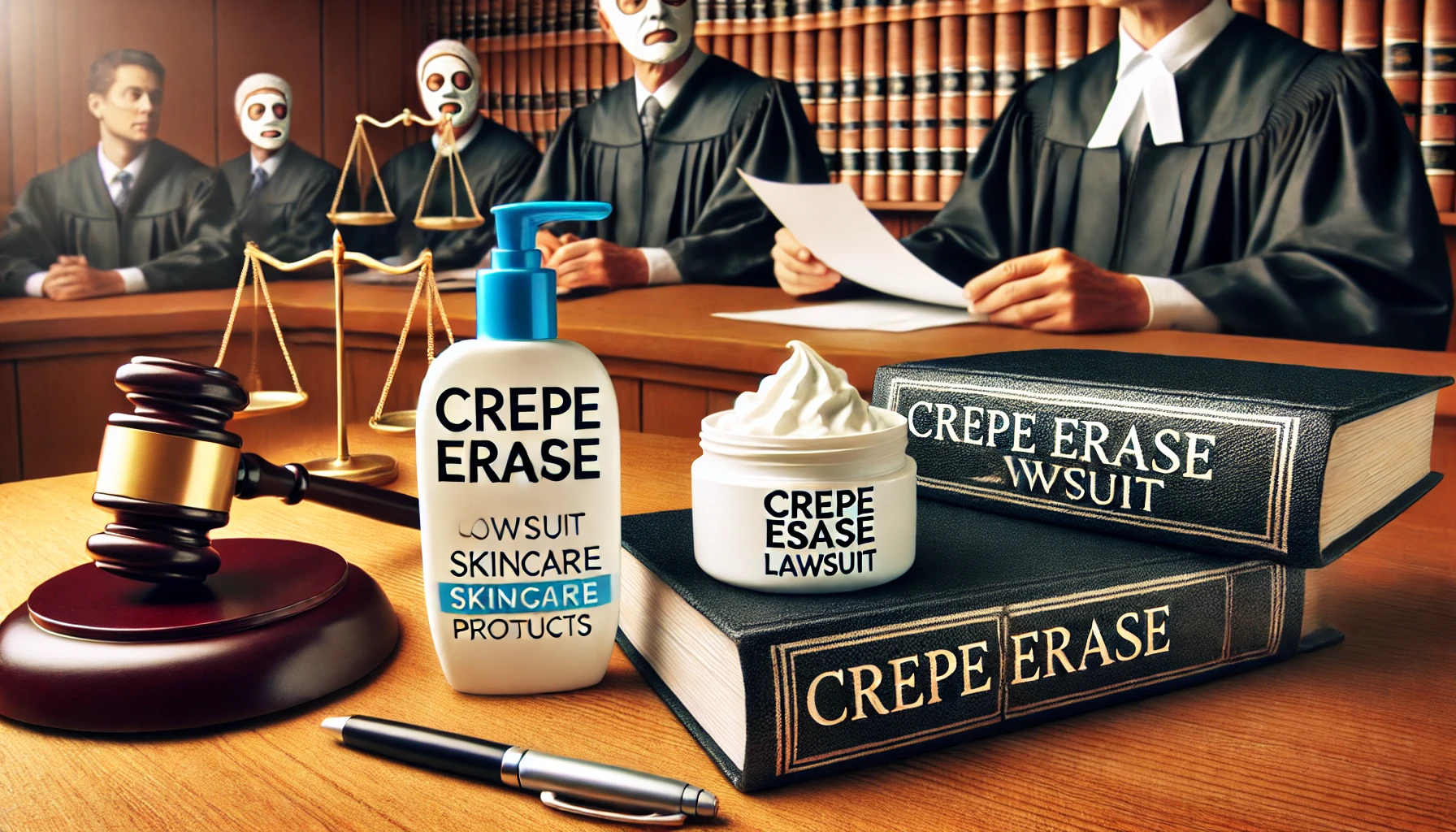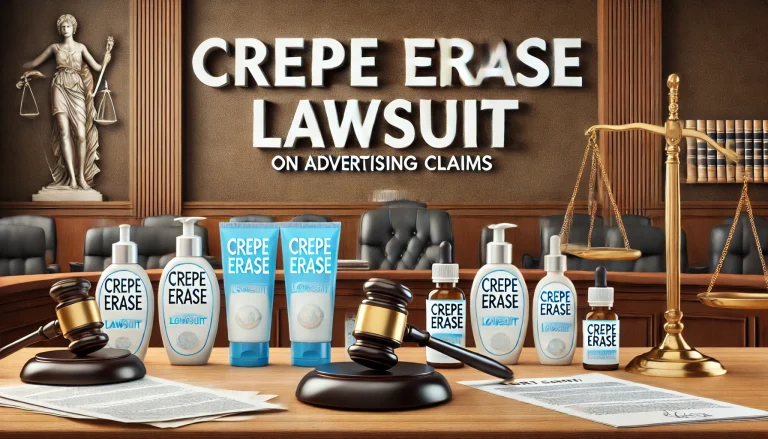Crepe Erase, a skincare brand known for its focus on reducing “crepey skin,” has been the subject of controversy due to the Crepe Erase lawsuit filed by consumers as a class action. The lawsuit alleges false advertising, unfulfilled promises, and ineffective products. This has raised questions about how beauty products are marketed and whether companies are being transparent about the results they claim. This article explores the details of the Crepe Erase lawsuit, what it means for consumers, and how it could affect the beauty industry as a whole.
Crepe Erase Lawsuit: Understanding the Allegations and Consumer Concerns
The Crepe Erase lawsuit has brought significant attention to the beauty and skincare industry. Filed as a class action by dissatisfied consumers, the lawsuit accuses the company of false advertising and making exaggerated claims about the effectiveness of its products. Crepe Erase, a skincare brand marketed to reduce the appearance of “crepey skin,” promised visible and transformative results that many customers say they never experienced.
Consumers have reported frustration with the lack of results, as well as dissatisfaction with the company’s customer service, including issues with refunds and support. Some users also reported adverse side effects, such as redness and irritation, which were not prominently disclosed. These concerns have sparked broader discussions about transparency and honesty in skincare marketing.
At the heart of the lawsuit is the allegation that Crepe Erase used deceptive marketing practices, such as celebrity endorsements and dramatic claims, without providing sufficient scientific evidence to back them up. As the legal case progresses, it could lead to changes in advertising standards within the beauty industry, ensuring greater protection for consumers and more accountability for brands.
For consumers, this lawsuit highlights the importance of researching skincare products, understanding marketing tactics, and being aware of their rights when making purchases.
Background on Crepe Erase
What is Crepe Erase? Crepe Erase is a skincare brand created to target crepey skin, a term used to describe skin that is thin, wrinkled, and sagging. It is often seen as a sign of aging or damage from environmental factors like sun exposure. Crepe Erase promises to hydrate and firm up these areas, including common trouble spots like the arms, neck, and knees. Some of the brand’s popular products include the Crepe Erase Ultra Smoothing Body Lotion and Advanced Firming Extreme Repair Treatment. These products are marketed to repair the appearance of crepey skin by boosting skin’s elasticity and smoothness.
Marketing Campaigns Crepe Erase has invested heavily in celebrity endorsements, most notably actress Jane Seymour, who has served as a spokesperson for the brand. Through these campaigns, Crepe Erase has successfully positioned itself as a premium skincare solution. The brand’s marketing promises quick and visible results, claiming improvements within weeks of regular use. These bold claims have attracted a large following, but they have also sparked skepticism as the effectiveness of these products has been called into question by consumers.
The Allegations
False Advertising The primary issue at the heart of the lawsuit is the accusation of false advertising. Consumers claim that Crepe Erase made exaggerated statements about the product’s ability to reverse the appearance of crepey skin. Despite using the products for extended periods, many individuals reported seeing little to no visible improvement in their skin. The lawsuit argues that the brand’s marketing did not adequately reflect the actual results, leading customers to believe they would experience much more dramatic effects than what the products actually provided.
Consumer Complaints Several consumers have expressed frustration with the company’s return and refund policies. Many found that their efforts to get a refund were met with difficulties or a lack of response. Other customers felt that they were misled by the product’s advertising, claiming that the results they were promised were unrealistic. These experiences have fueled growing discontent and a desire for greater transparency in advertising and consumer rights.
Adverse Reactions In addition to issues with product effectiveness, some users reported adverse reactions to Crepe Erase products. Common complaints included skin irritation, redness, and a burning sensation after use. These side effects were not adequately addressed in the brand’s marketing materials, leading some customers to feel that they had been misinformed about the potential risks. While adverse reactions may not be widespread, the lack of clear warnings about possible side effects contributed to the negative perception of the brand.
Legal Proceedings
Details of the Lawsuit The lawsuit was initiated by consumers who felt they had been deceived by the product’s misleading claims. It has been filed as a class action lawsuit, meaning that individuals who purchased Crepe Erase products and had similar negative experiences could join the case as plaintiffs. The legal team representing these consumers argues that Crepe Erase violated consumer protection laws by promoting unproven benefits that misled customers into making purchases.
Arguments by Plaintiffs The plaintiffs claim that Crepe Erase’s advertisements and promotional materials were misleading, particularly when they presented the products as providing visible, quick results. They argue that the brand did not provide scientific evidence to support its claims, nor did it offer sufficient information regarding the variability of results depending on a person’s skin type, age, or lifestyle. The plaintiffs are asking for financial compensation and are seeking to hold Crepe Erase accountable for its advertising practices.
Defense by Crepe Erase In its defense, Crepe Erase has acknowledged that results can vary from person to person. The brand emphasizes that it provides disclaimers about the variability of outcomes and that the products may work differently for each individual. They also argue that their advertising is based on real customer testimonials and that they have not made any false or exaggerated claims. While the company has not admitted to any wrongdoing, it has made efforts to address the complaints and improve its customer service practices.
Impact on the Industry
Consumer Trust
The outcome of the Crepe Erase lawsuit could have lasting effects on consumer trust in the beauty industry. If the brand is found to have misled consumers, it may lead to more skepticism about other skincare products, particularly those that claim miraculous results. Consumers may begin to demand more proof and transparency from beauty brands, which could push companies to be more honest and realistic about the effectiveness of their products.
Regulatory Oversight
This case could also have broader implications for how the beauty industry is regulated, particularly in terms of marketing. Currently, the Federal Trade Commission (FTC) monitors and enforces truth in advertising regulations, but this case could lead to calls for stricter rules. If the lawsuit results in a significant ruling, it might prompt other skincare brands to reconsider how they advertise their products. Clearer regulations could help prevent deceptive claims and protect consumers from being misled.
Lessons for Consumers
Importance of Research
One of the most important takeaways from the Crepe Erase lawsuit is the need for consumers to do their own research before purchasing skincare products. It’s crucial to read reviews, seek out independent expert opinions, and look for clinical studies or scientific evidence to support the claims made by brands. Consumers should not solely rely on celebrity endorsements or before-and-after photos, as these can be misleading.
Understanding Marketing Tactics
Many skincare brands, including Crepe Erase, use strong marketing tactics to attract customers. These include celebrity endorsements, eye-catching advertisements, and promises of dramatic results. While these strategies can be persuasive, they are designed to encourage impulse buying. By understanding how marketing works, consumers can approach these products with a more discerning mindset.
Awareness of Consumer Rights
The lawsuit highlights the importance of knowing your rights as a consumer. If a product does not meet expectations or causes negative side effects, consumers should know they can file a complaint or request a refund. Being informed about consumer protection laws can help individuals avoid being taken advantage of and empower them to demand better from companies.
Current Status and Future Implications
Updates on the Case
As of now, the Crepe Erase lawsuit is ongoing. The case is being closely monitored by legal experts and consumer advocates, as its outcome could set a precedent for future legal challenges against skincare brands. While no final decision has been made, the lawsuit continues to make waves in the beauty industry and has sparked a larger conversation about the ethics of beauty marketing.
Possible Outcomes
The lawsuit could result in a variety of outcomes. If Crepe Erase is found guilty of false advertising, the company could be forced to pay financial compensation to affected consumers and change its marketing practices. A settlement is also possible, where the brand may offer refunds or compensation without admitting any wrongdoing. Additionally, if the case is not successful, it could signal to other companies that such lawsuits may not result in significant consequences.
Long-Term Implications
Beyond the immediate outcome of the lawsuit, the case could have long-term effects on how beauty brands advertise their products. If the lawsuit results in stricter regulations or an industry-wide shift in advertising standards, it could change the way companies communicate the effectiveness of their products. Consumers might also become more cautious about believing extreme claims, leading to a more informed and discerning market.
Conclusion
The Crepe Erase lawsuit serves as a reminder of the importance of transparency in marketing and consumer protection. It highlights the need for consumers to be cautious about the products they buy and to be aware of their rights. As the case continues, it may prompt significant changes in the skincare industry, particularly regarding advertising and product claims. For now, consumers should continue to research and carefully consider the promises made by brands before making a purchase.
By staying informed and aware of marketing tactics, consumers can protect themselves from misleading advertisements and ensure that they make choices based on evidence and not just hype. The outcome of this lawsuit could shape the future of skincare marketing, ultimately benefiting consumers and encouraging brands to be more honest about what their products can truly do.
FAQs
What is the Crepe Erase lawsuit about?
The lawsuit alleges that Crepe Erase engaged in false advertising by making exaggerated claims about the effectiveness of its products.
Who filed the lawsuit against Crepe Erase?
The lawsuit was filed as a class action by consumers who felt misled by the product’s marketing and results.
What are the main complaints from consumers?
Consumers reported little to no visible improvement, adverse skin reactions, and difficulties with refunds or customer service.
What is Crepe Erase’s response to the allegations?
The company claims results vary by individual, defends its use of testimonials, and emphasizes that disclaimers were provided.
What could be the potential outcome of this lawsuit?
The case may lead to financial compensation for consumers, changes in marketing practices, or stricter industry regulations.
Article Recommendations
Sheetz Lawsuit Background Checks Debate: Are Blanket Hiring Policies Putting Companies at Risk?
UWM Lawsuit 2024: Why the Mortgage Industry Is Watching These Legal Cases Closely
Sparta Mesothelioma Legal Question: Exploring Compensation, Lawsuits, and Asbestos Trust Funds




